Content
Cherries do not bud in spring for a number of reasons that depend not only on the gardener. In order for the plant to feel comfortable on the site and give a stable harvest, varieties are chosen specially bred for the region and adapted to weather conditions.
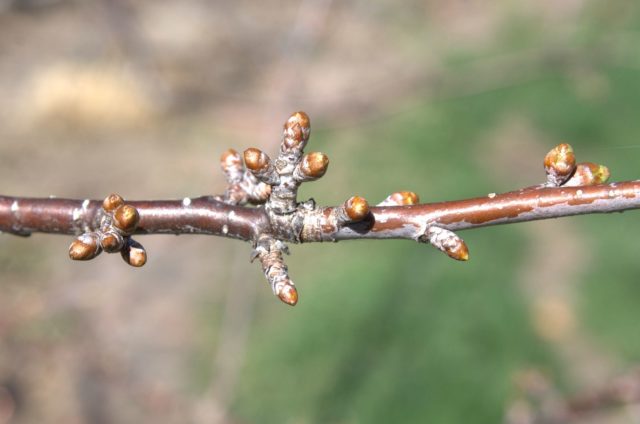
Normal kidney condition in early spring
When cherry leaves bloom in spring
Cherries are classified as fruit crops of early fruiting. The beginning of sap flow - in the spring - from the moment the snow melts and the daytime temperatures rise to above zero. The first stage of the biological cycle is flowering, flowers are formed before the vegetative buds fully bloom, or simultaneously with them. Time depends on the variety and region of growth:
- roughly in the middle lane - from the second half of May;
- in the Leningrad region - two weeks later;
- in the south - in April;
- in Siberia - late May - early June.
Duration of flowering - 14 days at a temperature not lower than +100if the weather conditions do not correspond to the biological requirements of the culture, the dates are shifted. This means that vegetative buds should bloom in late May or mid-June. Each climatic zone has its own terms. At an early stage of the growing season, it is difficult to determine the problem, since the buds on the cherry may appear green in appearance, and not bloom at the proper time.
When there are no leaves on the tree during the period of flower formation, this is normal. If ovaries have appeared, and the vegetative buds have not started to grow, something is wrong with the tree. You can determine the problem by flowering: it is weak, most of the ovaries are crumbling. Those that remain are unlikely to live up to biological ripeness.
The main reasons why cherries do not bud
The fruit culture is unpretentious in care, it grows throughout the territory of Russia, except for the Far North. Reacts calmly to drought and temperature changes. Mostly no problem for the gardener. But, like any plant, the tree needs proper care. There can be several reasons why cherries do not bloom after winter: from improper planting to the inappropriateness of the variety to the climate of the region.
Violation of landing rules
In case of improper planting, leaves do not bloom, mainly in young seedlings. A mature tree will have a different problem. A few examples of errors when placing cherries on a plot:
- the composition of the soil does not correspond - for the culture it must be neutral;
- the place was chosen incorrectly - the north side with the presence of drafts;
- the seedling is shaded by tall trees with a spreading crown - not enough ultraviolet radiation for photosynthesis;
- the soil is constantly wet - the site was chosen unsuccessfully, it is located in a lowland, in a swampy area or groundwater is nearby;
- the size of the planting pit does not correspond to the volume of the root system - air cushions are possible, the absence of a drainage layer;
- the time was wrong - in the spring the cherries were planted too early, when the soil did not have time to warm up enough. In autumn, on the contrary, the work was carried out late, the plant did not have time to take root well before the onset of frost.
It looks like a knotty compaction above the root; when planting, the neck is left on the surface - about 6 cm from the ground level.
Violation of the rules of care
If the planting is carried out on time and in compliance with all requirements, the reason may be incorrect or insufficient agricultural technology. In this case, they are also guided by the peculiarities of the climate of the region. If in the south the reason, for example, will be in watering, then in a temperate climate - this is the wrong preparation for winter.
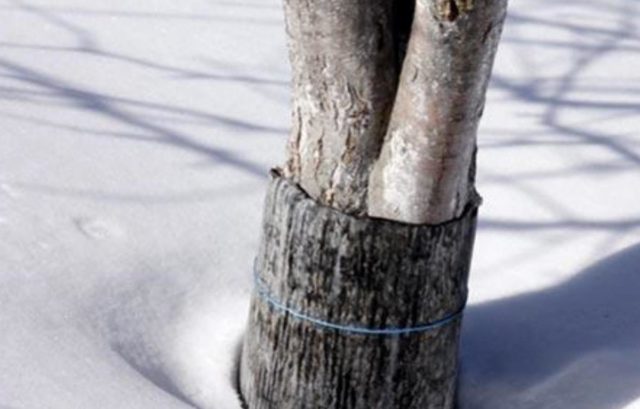
Method of protection against frost and rodents
Watering
For an adult cherry that has entered the fruiting stage, watering is not the main condition for agricultural technology. The culture is quite drought-resistant. She needs two plentiful watering from the second half of summer, if there are abnormally high temperatures without precipitation.
Cherry has a well-developed and deepened central root; it replenishes the moisture deficit from the soil. For an adult plant, autumn water-charging watering is more relevant. Fruiting occurs at a time when the temperature indicator does not rise much, even in the south.
Seedlings up to three years of vegetation are watered with a small amount of water twice a month in spring. In the summer they look at the weather. The plant will more easily tolerate a lack of moisture than an excess of it. But it is also impossible to allow the soil to dry out.
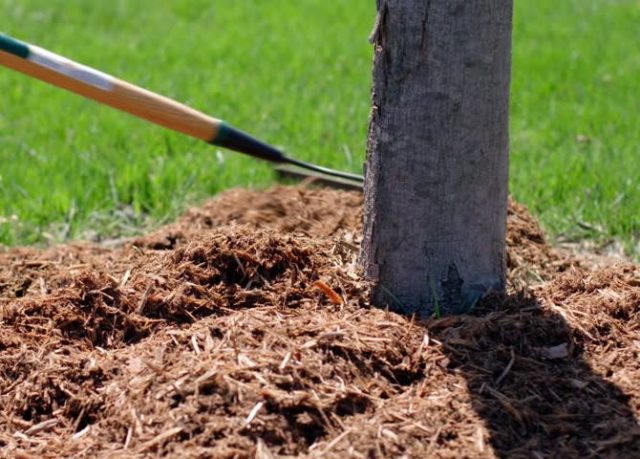
The root circle is mulched - this method protects the root from burns and retains moisture in summer
With wet soil and a sharp drop in temperature, part of the root may die, in the spring the buds will remain dormant from lack of nutrition, the leaves on the cherry will not bloom.
Top dressing
When planting, a nutritious substrate is introduced into the pit, it is enough for a seedling for three years of growth, young cherries are not fed during this period. If the buds have not blossomed on the tree when this condition is met, the reason is not feeding. Without a nutrient mixture, the plants are fed in the spring with organic matter: over the summer, phosphate and potassium fertilizers are applied in accordance with the instructions. The next season, cherry leaves will appear at the right time.
An adult tree is fertilized before flowering, before the formation of berries and in autumn. If an adult cherry does not bloom in the spring with timely fertilizing, the reason may be a soil mismatch. Once every 3-4 years, the composition is normalized in accordance with the indicator.
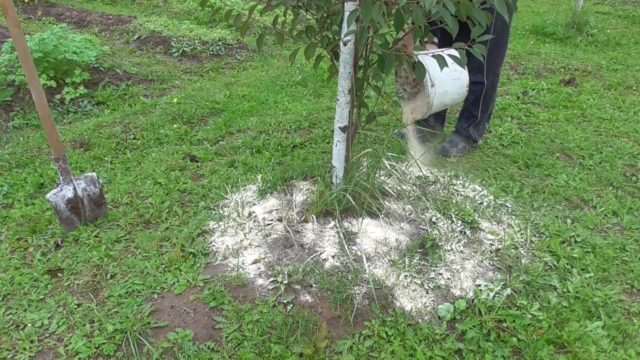
Dolomite flour is added to acidic soil, alkaline soil is neutralized with granular sulfur
Pruning
This agricultural technique is required for cherries at any age, starting from the moment of planting. The seedling is shortened by shoots to 4-6 fruit buds in order to direct the growing season to the development of the root system. Failure to comply with the condition may cause the absence of leaves in the spring. If the seedling is poorly rooted, then it cannot fully provide itself with nutrition, the kidneys will remain underdeveloped.
An adult plant begins to shape by pruning from the fourth year of growth. The measure is necessary to prevent thickening of the crown. Cherry can react to an overload with a ground mass by drying out part of the buds.

The event for the formation of skeletal branches is carried out in early spring or autumn, along the way, dry and twisted shoots are removed
The plant forms fruit buds at the tops, they cannot be shortened by more than 50 cm.
Poor preparation of cherries for winter
Preparatory measures for winter are a prerequisite for a temperate climate. If you allow freezing of the branches, they can be cut in the spring. During the season, the cherry will recover. If the root or stem is broken, there is a risk of death of the culture, especially the young one. Often, poor preparation for winter is the reason for the lack of leaves on cherries. For the winter, the young tree is spud, the trunk is wrapped with cloth to the lower branches, the layer of mulch is increased.

After icing, the leaves on the cherry will not
Freezing of roots, trunk and crown
In early spring, the problem can be identified by the condition of the crown and wood.

Trim multiple branches in different parts and determine the severity of the problem by cutting
In healthy cherries, the cambium (the layer of tissue near the bark) is green, it is well defined on the cut, the wood is white with a cream shade.
If the color of the cambium is black, the tissue is brown with a pronounced border of the core - the branch has died, it will no longer be able to recover. How severe the damage can be can be determined at the time of flowering. Viable branches are left, the rest are drastically cut off.
If there are viable areas on the tree, then the trunk and roots are not completely damaged. There is a chance that the cherry will recover and gradually recover. In the case when there are no flowers, the buds did not open, the tree is unlikely to be saved.
Weather
This cause of kidney damage is independent of the grower. The only thing that needs to be taken into account is the frost resistance of the variety when buying. In winter, vegetative buds are not afraid of a drop in temperature; they are covered with a scaly, tightly fitting protective layer. The main threat to an unadapted variety to temperate or temperate continental climates in early spring is the time of frost.
Spring frosts
Returning spring frosts are frequent in temperate climates. They become a serious reason why buds do not bud. When the plant enters the growing season, sap flow begins. Low temperatures cause the sap to freeze: it stops, increases in size and tears the wood tissue.
After climate stabilization, the supply of nutrients is insufficient due to damaged areas, the buds dry out and crumble. These are internal problems. In early spring, the buds begin to grow, the top layer opens, the cherry becomes vulnerable to frost. The buds freeze and there is no need to wait for leaves.
Diseases
Infections during the growing season weaken the cherry, during the season, young shoots do not have time to ripen, in the spring the buds will not open on them.
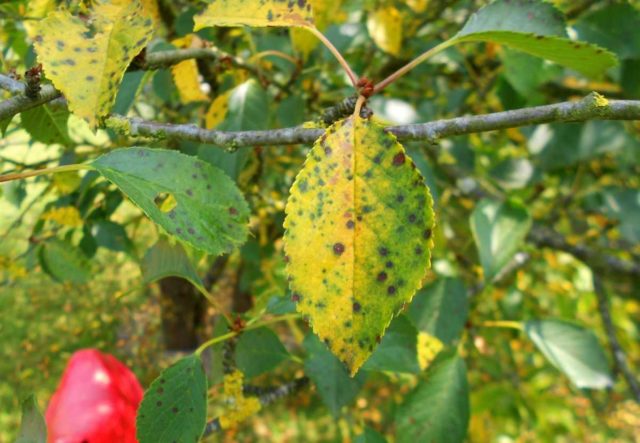
Leaves do not bloom on cherries with coccomycosis
Spores of the fungus are in the bark of trees in winter, the active phase occurs at the time of sap flow, the growth of a colony can completely destroy the buds.
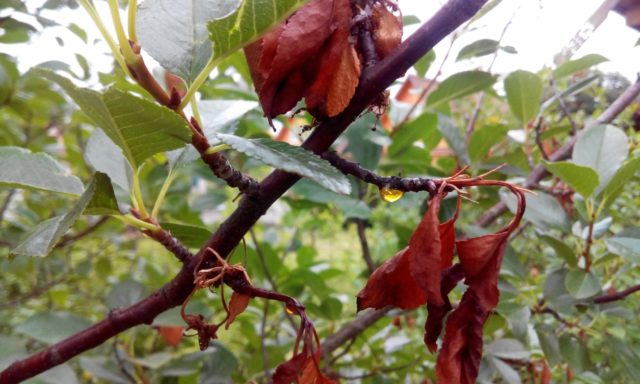
Leaves do not bloom on cherries with a bacterial burn
The disease causes blackening of the branches, the bark becomes soft, gum flows out intensively. The buds die before they bloom.
Pests and rodents
Buds do not bloom due to the presence of pests. Most of the parasitic insects are a threat to cherries. They hibernate as a pupa in the bark of a tree. In spring, adults lay eggs, depending on the species, caterpillars appear in two weeks.
A particular danger is posed by:
- Brown tick, its larvae feed on the juice of the kidneys. With a massive accumulation, most of the crop will die. You can determine the defeat by drying the leaves.
- The kidney mite lays eggs. Outwardly, the cherry in the spring looks quite healthy: the buds are swollen, increased in size, but do not bloom. The larva, until it reaches the required mass, is inside the kidney, so the size seems to be normal. But with a detailed examination, the pest is determined.
- The black cherry aphid also feeds on the juice of the buds - they shrink and dry out.
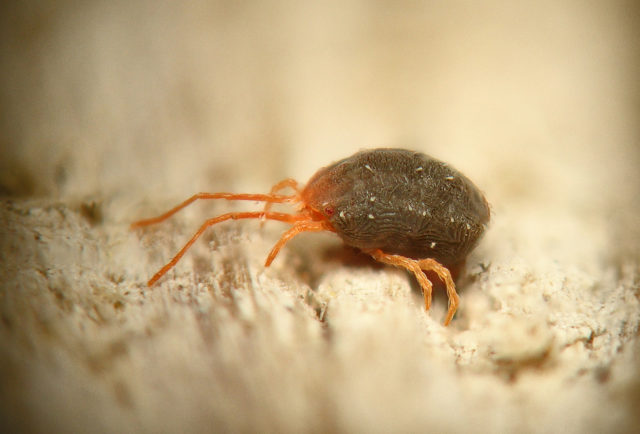
Adult brown fruit mite
Rodents do great harm to young cherries. They feed on young root shoots. In spring, the damaged system cannot provide itself with food, the cherry is left without leaves. If the bark is damaged, the plant will not only not produce leaves, but may die in winter.
What to do if cherries do not bud at the right time
First and foremost, it is important to try to determine the causes by excluding all possible options. Then take measures to eliminate them:
- If the planting conditions are violated, the tree is transferred to another area or groundwater is diverted if the reason is high humidity.
- Correct the requirements of agricultural technology - increase or decrease watering, make top dressing in compliance with the schedule.
- If the roots of a young tree are frozen over, the leaves do not bloom - the cherry is removed from the ground, the damaged areas are cut off. It is treated with a disinfectant and placed in a growth-stimulating preparation for 12 hours. Then they return the tree to its place.
- If the branches are damaged by frost, they are cut off, the cuts are lubricated with garden var.
- If the bark is damaged more than 60%, it will not work to save the cherry.
- If damaged by spring frosts, the tree will recover on its own, but it will not yield a harvest. Change the variety to a more winter-hardy one.
They do the same with infection. This reason is easy to eliminate, next year the leaves of the cherry will appear in due course.
Prevention measures
Preventive measures include:
- loosening the soil near the cherry in the fall so that pests wintering in the soil die;
- weed removal, collection of dry leaves;
- whitewashing the trunk;
- sheltering plants for the winter;
- treatment for infection;
- location near cherries of drugs toxic to rodents;
- sanitary and formative crown pruning.
Conclusion
Cherries do not bud for many reasons. The main thing is to identify and eliminate them in a timely manner. This problem often occurs with young trees if agricultural techniques and planting requirements are not followed. Pests, diseases and incorrect pruning can be the reason for the absence of leaves on an adult tree.








